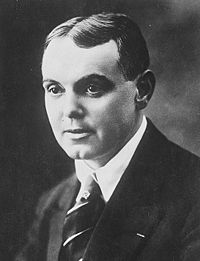You can help expand this article with text translated from the corresponding article in French. (May 2024) Click for important translation instructions.
|

Pierre Mac Orlan, sometimes written MacOrlan (born Pierre Dumarchey; February 26, 1882 – June 27, 1970), was a French novelist and songwriter.
His novel Quai des Brumes was the source for Marcel Carné's 1938 film of the same name, starring Jean Gabin. He was also a prolific writer of chansons, many of which were recorded and popularized by French singers such as Juliette Gréco, Monique Morelli, Catherine Sauvage, Francesca Solleville, and Germaine Montero.
Life
Born in Péronne, Somme, in northern France, Mac Orlan lived in Rouen and Paris as a young man, working at a variety of jobs and learning to play the accordion. In his twenties, he travelled widely in Europe, before returning to Paris and becoming a noted figure in bohemian art circles. In particular, his song performances were a regular feature at the Lapin Agile cabaret. During this period, he was part of a broad circle of writers and painters including Max Jacob, Guillaume Apollinaire, Maurice Utrillo and Francis Carco.
He fought in the war against Germany until wounded in 1916, after which he worked as a war correspondent. In later years he earned a living as a writer in Saint Cyr-sur-Morin, outside Paris. In the late 1920s he became an influential critic of film and photography, writing important essays about the work of Eugène Atget, Germaine Krull and others.
Works
In addition to Quai des Brumes, his many novels included A Bord de l'Etoile Matutine, translated into English by Malcolm Cowley as On Board the Morning Star, and La Bandera (1931). Among the popular chansons written by Mac Orlan are "Fille de Londres", "Le Pont du Nord" and "Nelly". The French singer Germaine Montero released an extensive set of her interpretations of Mac Orlan songs on the CD Meilleur de Germaine Montero. Most recently, new English translations of his books A Handbook for the Perfect Adventurer, translated by Napoleon Jeffries (2013), and Mademoiselle Bambù, translated by Chris Clarke (2017), have been published in the United States by Wakefield Press.
Using his real name, Pierre Dumarchey, and various pseudonyms including: Docteur Fowler, Pierre du Bourdel, Pierre de Jusange, Sadie Blackeyes, Chevalier de X, and Sadinet, he was for several years a writer for Paris Sex-Appeal, and of pornographic novels, which frequently depicted flagellation and sado-masochism. These titles include: La Comtesse au fouet (1908), the story of a cruel dominatrix, Les Grandes Flagellées de l'histoire (1909), Lise Fessée (1910), Masochism in America (1910), Miss (1912), and Petite dactylo et autres textes de flagellation (1913). He told Pascal Pia that he used the Dumarchey name to upset an uncle of his who made his life hard.
Influences and legacy
The French writer and political theorist Guy Debord, founder of the Situationist International was a constant reader of Mac Orlan's novels of urban adventure and "low life". The well-known photographer of New York in the 1930s Berenice Abbott was highly influenced by Mac Orlan's writings on the "fantastique" and the "social fantastique". The physicist Freeman Dyson, in his 2008 AMS Albert Einstein Lecture, interprets MacOrlan's song "La Ville Morte" ("The Dead City") as an example of the "empty city archetype", a Jungian archetype as described by mathematician Yuri I. Manin.
Filmography
- La Bandera, directed by Julien Duvivier (1935, based on the novel La Bandera)
- Port of Shadows, directed by Marcel Carné (1938, based on the novel Le Quai des brumes)
- Midnight Tradition, directed by Roger Richebé (1939, based on the novel La Tradition de minuit)
- Marguerite de la nuit, directed by Claude Autant-Lara (1955, based on the novel Marguerite de la nuit)
Screenwriter
- L'Inhumaine, directed by Marcel L'Herbier (1924)
- Le Choc en retour [fr], directed by Georges Monca and Maurice Kéroul (1937)
- Voyage Without Hope, directed by Christian-Jaque (1943)
- François Villon, directed by André Zwoboda (1945)
References
- Francis Carco, The Last Bohemia, translated by Madeline Boyd, New York: Henry Holt & Company, 1928.
- ^ Pia, Pascal (1978). Les Livres de l'Enfer: bibliographie critique des ouvrages érotiques dans leurs différentes éditions du XVIe sièlce à nos jours. C. Coulet et A. Faure. p. 546. ISBN 978-2-902687-01-5.
- ^ Baritaud, Bernard (1992). Pierre Mac Orlan. Sa vie, son temps. Histoire des idées et critique littéraire. Vol. 313. Librairie Droz. p. 341. ISBN 978-2-600-03693-1.
- Rifkin, Adrian (1995). Street noises : Parisian pleasure, 1900-40. Manchester: Manchester University Press. p. 106. ISBN 0-7190-4589-4. OCLC 48866037.
- Kearney, Patrick J. (1982). A History of Erotic Literature. Parragon. p. 161. ISBN 978-1-85813-198-6.
- Harris, P. R. (1991). The Library of the British Museum: retrospective essays on the Department of Printed Books. British Library. p. 222. ISBN 978-0-7123-0242-5.
- Pascal Pia, Les Livres de l'enfer, du XVIe siècle à nos jours (1978), quoted in Bernard Baritaud (1992), p. 27.
- Andy Merrifield (2005), Guy Debord - (Critical Lives), London: Reaktion Books, 2005, pp. 145–6.
- Andy Merrifield (2004), "The sentimental city: the lost urbanism of Pierre Mac Orlan and Guy Debord", International Journal of Urban and Regional Research, Volume 28, Issue 4, pp. 930–940, December 2004.
- See Peter Barr's PhD dissertation "Becoming Documentary: Berenice Abbott's Photographs, 1929–1939" (Boston University, 1997).
- Freeman J. Dyson (February 2009). "Birds and Frogs" (PDF). Notices of the American Mathematical Society. 56 (2): 222.
External links
- Alexis Lykiard, "Mac Orlan" (brief biography)
- Andy Merrifielod, "The Strange Odyssey of Pierre Mac Orlan", The Brooklyn Rail, 1 September 2004. Notes on Mac Orlan by Guy Debord biographer
- "Georges Brassens and the French 'Renaissance of Song'", Bureau of Public Secrets, References to Mac Orlan's popular songs
- Pierre Mac Orlan, James Russell, Neil Philip "Boutiques"], Mainstone Press, London 2022. A translation of Pierre Mac Orlan's 1925 book Boutiques (trans. by Shaun Whiteside) with illustrations by Lucien Boucher and essays and text by Andrew Stewart, James Russell and Neil Philip.